List of Soviet Union military equipment of World War II
The following is a list of Soviet military equipment of World War II which includes artillery, vehicles and vessels. World War II was the deadliest war in history which started in 1939 and ended in 1945. Following political instability built-up in Europe from 1930, Germany, which aimed to dominate Europe, attacked Poland on 1 September 1939, marking the start of World War II. The USSR (Soviet Union) joined the attack on Poland from 17 September 1939. The war in Europe ended on 8 May 1945 with the capitulation of Germany to the allied (including Soviet) forces. By the end of the war, the Soviet Union produced 19.8 million rifles; 1,477 million machine guns; 516,648 artillery guns; 347,900 mortars; 119,769 tanks and SPGs; 265,600 army trucks; 213,742 military aircraft; 2 cruisers; 25 destroyers; 52 submarines.[1]
Knives
| Name | Type | Origin | Photo | Notes |
|---|---|---|---|---|
| NR-40 | Knife | Soviet combat knife that was produced after the Winter War in 1940. | ||
| AVS-36 | Bayonet/Knife |  | Soviet bayonet knife issued with the AVS-36 automatic rifle. The fact that the AVS-36 was used in very limited numbers; most without the bayonet; made it very rare. |
Small arms
Revolvers and pistols
| Name | Type | Cartridge | Origin | Photo | Notes |
|---|---|---|---|---|---|
| Nagant M1895 | Revolver | 7.62×38mmR |  | 7-round cylinder. | |
| Tokarev TT-33 | Semi-automatic pistol | 7.62×25mm Tokarev | .jpg.webp) | 8-round magazine. Widely used by officers, did not fully replace the Nagant M1895. | |
| Mauser C96 | Semi-automatic pistol | 7.63×25mm Mauser | .jpg.webp) | 10-round internal magazine. Small amount captured from German forces. |
Rifles, sniper rifles and battle rifles
| Name | Type | Cartridge | Origin | Photo | Notes |
|---|---|---|---|---|---|
| Mosin–Nagant M1891/30 | Bolt-action rifle / Sniper rifle (with 3.5× PU scope attached) | 7.62×54mmR |  | 5-round internal magazine. Most widely used bolt-action rifle by the Red Army. | |
| Mosin–Nagant M1938 Carbine | Bolt-action rifle | 7.62×54mmR |  | 5-round internal magazine. | |
| Mosin–Nagant M1944 Carbine | Bolt-action rifle | 7.62×54mmR | 5-round internal magazine. | ||
| Tokarev SVT-38 | Semi-automatic rifle | 7.62×54mmR | 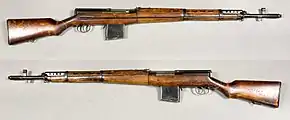 | 10-round magazine. | |
| Tokarev SVT-40 | Semi-automatic rifle / Sniper rifle (with 3.5× PU scope attached) | 7.62×54mmR | 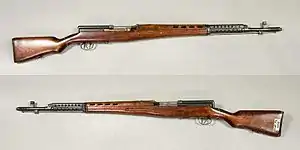 | 10-round magazine. Most widely used semi-automatic rifle by the Red Army. | |
| Federov Avtomat | Battle rifle | 6.5×50mmSR Arisaka | 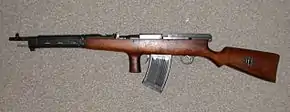 | 25-round magazine. Deployed during the Winter War from stockpiles due to a shortage of submachine guns.[2] | |
| Simonov AVS-36 | Battle rifle | 7.62×54mmR | 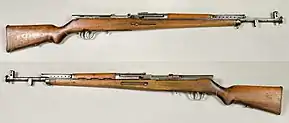 | 15-round magazine. Produced from 1934–1940, it was mostly withdrawn in 1941 due to issues. Used primarily during the Winter War. | |
| Tokarev AVT-40 | Battle rifle | 7.62×54mmR |  | 10-round magazine. Modified SVT-40 with a different firing selector. Produced from May 1942 until halted in the summer of 1943 due to mostly uncontrollable automatic fire and breakage. |
Submachine guns
| Name | Type | Cartridge | Origin | Photo | Notes |
|---|---|---|---|---|---|
| PPD-34 | Submachine gun | 7.62×25mm Tokarev |  | 25-round magazine. Based and adapted from the Suomi KP/-31, was not produced in larger quantities until 1937–1939. | |
| PPD-34/38 / PPD-40 | Submachine gun | 7.62×25mm Tokarev |  | 71-round magazine. | |
| PPSh-41 | Submachine gun | 7.62×25mm Tokarev |  | 35, 71-round magazine. Most widely used Soviet submachine gun. | |
| PPS-42 / PPS-43 | Submachine gun | 7.62×25mm Tokarev |  | 35-round magazine. | |
| Thompson M1928A1 | Submachine gun | .45 ACP |  | 20, 30, 50-round magazine. 137,790 supplied by the United States during the Lend-Lease program. | |
| M50 Reising | Submachine gun | .45 ACP | 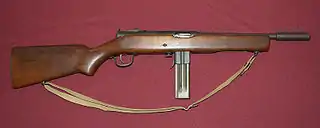 | 12, 30-round magazine. Supplied by the United States during the Lend-Lease program. |
Machine guns
| Name | Type | Cartridge | Origin | Photo | Notes |
|---|---|---|---|---|---|
| DP-27 | Light machine gun | 7.62×54mmR | 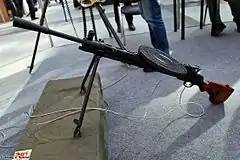 | 47-round magazine. Most widely used light machine gun by the Red Army. | |
| DS-39 | Medium machine gun | 7.62×54mmR | 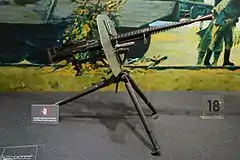 | 250-round belt. | |
| SG-43 Gorunov | Medium machine gun | 7.62×54mmR |  | 200, 250-round belt. | |
| PM M1910 | Heavy machine gun | 7.62×54mmR | 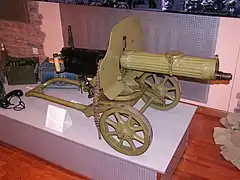 | 250-round belt. | |
| DShK 1938 | Heavy machine gun | 12.7×108mm | _(5869956228).jpg.webp) | 50-round belt. | |
| RPD | Light Machine Gun | 7.62x39mm | 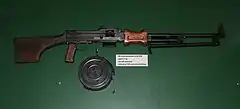 | 100-round belt. Never saw combat in WW2, deployed in insignificant numbers in 1945 for trials, but never frontline service. | |
| Bren Gun | Light Machine Gun | 303 British | 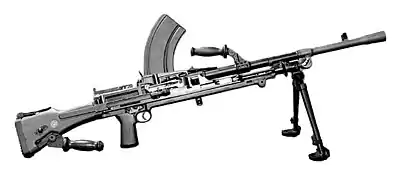 | 30-round detachable box magazine. 2487 supplied by the British Empire during the Lend-Lease program, many mounted on Universal Carriers. |
Explosives, hand-held anti-tank and incendiary weapons
Grenades and grenade launchers
| Name | Type | Diameter | Origin | Photo | Notes |
|---|---|---|---|---|---|
| Model 1914 grenade | Fragmentation grenade | 45mm |  | Limited usage during World War II. | |
| F1 grenade | Fragmentation grenade | 55mm | 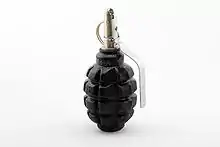 | Widely produced grenade. Nicknamed the "limonka" (lemon). | |
| RG-41 | Fragmentation grenade | 55mm | 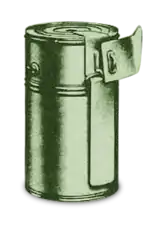 | 5 meter kill radius. | |
| RG-42 | Fragmentation grenade | 54mm |  | Produced in 1942 to replace the complex RGD-33. Soviet partisans made copies of it when they were located behind enemy lines. | |
| RGD-33 grenade | Fragmentation grenade | 45mm, 54mm (with fragmentation sleeve) |  | 10–15 meter kill radius. | |
| RPG-40 / RPG-41 | Anti-tank grenade | 20 cm |  | Effective against tanks up to 20mm of armour. | |
| RPG-43 | Anti-tank grenade | 95mm |  | Improved version of the RPG-40. Effective against tanks up to 75mm of armour. | |
| RPG-6 | Anti-tank grenade | 103mm | Improved version of the RPG-43. Effective against tanks up to 100mm of armour. | ||
| Dyakonov grenade launcher | Grenade launcher | 40.5mm |  | Grenade launcher attachment for Mosin-Nagant rifle. There were four other versions of the grenade besides the main high explosive one. |
Mines
| Name | Type | Detonation | Origin | Photo | Notes |
|---|---|---|---|---|---|
| TM-35 mine | Anti-tank mine | Pressure |  | 2.8 kg of TNT. | |
| TM-41 mine | Anti-tank mine | Pressure | .jpg.webp) | 3.9 kg of Amatol or TNT, short cylinder with the entire top surface being used as a pressure plate. | |
| TM-44 mine | Anti-tank mine | Pressure | .jpg.webp) | 5.4 kg of Amatol, broadly similar to the earlier, smaller, TM-41 mine. | |
| TMD-40 mine | Anti-tank mine | Pressure | 3.6 kg of Amatol. | ||
| TMD-44 / TMD-B mines | Anti-tank mine | Pressure |  | 9–9.7 kg of Amatol. |
Recoilless rifles
| Name | Type | Calibre | Origin | Photo | Notes |
|---|---|---|---|---|---|
| 76 K/DRP | Recoilless rifle | 76mm |  | Used during the Winter War. It was designed by L.V. Kurchevsky in 1930 and entered service in 1932. It was able to be mounted on GAZ-A trucks, becoming SU-4 self-propelled guns.[3] |
Infantry anti-tank rifles and rocket launchers
| Name | Type | Calibre | Origin | Photo | Notes |
|---|---|---|---|---|---|
| PTRD-41 | Anti-tank rifle | 14.5×114mm |  | Single-shot reloadable rifle. | |
| PTRS-41 | Anti-tank rifle | 14.5×114mm | 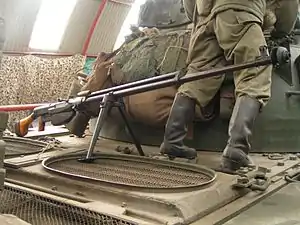 | 5-round internal magazine. | |
| M1 Bazooka | Recoilless anti-tank rocket launcher | 60 mm |  | Single-shot reloadable launcher. 8,500 supplied by the United States during the Lend-Lease program. | |
| PIAT | Anti-tank projectile launcher | 83mm |  | Single-shot reloadable launcher. 1,000 supplied by the British Empire during the Lend-Lease program. | |
| Panzerschreck | Anti-tank rocket launcher | 88mm |  | Single-shot reloadable launcher. Captured from German forces. | |
| Panzerfaust | Anti-tank recoilless gun | 149mm |  | Single-shot disposable launcher. Some were captured in 1944, while many were captured in 1945 from retreating German soldiers and Volkssturm. |
Flamethrowers and anti-tank incendiaries
| Name | Type | Origin | Photo | Notes |
|---|---|---|---|---|
| FOG-2 | Flamethrower | From 1941, around 15,000 were produced and used during World War 2. | ||
| ROKS-2 / ROKS-3 | Flamethrower |  | Produced from 1935–1945. Used also during the Soviet-Finnish War (1941–1944). | |
| Molotov cocktail | Improvised incendiary bottle | 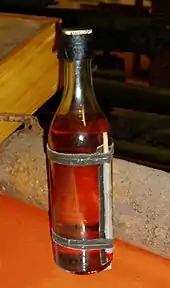 | Improvised incendiary bottles that were thrown at armoured vehicles. Invented by the Spanish Nationalists in the Spanish Civil War. First widely used by Finnish troops against the Soviets during the Winter War. | |
| Ampulomyot | Incendiary anti-tank ampulla-thrower | 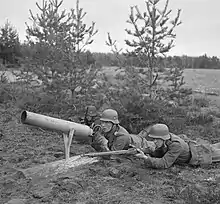 | 125mm incendiary spherical glass projectile. Use of it was limited in 1941, and became obsolete by 1942. | |
| Zuckermann's bottle-thrower | Incendiary anti-tank bottle launcher | Attachment for Mosin-Nagant rifles. Special bottles with incendiary mixtures were used. The bottles were produced in 1942, but became obsolete once Red Army troops were equipped with more anti-tank guns and rifles. |
Artillery
Light and heavy infantry mortars
| Name | Type | Origin | Photo | Notes |
|---|---|---|---|---|
| RM-38 | 50mm Infantry mortar | .jpg.webp) | Light infantry mortar. | |
| 82-BM-37 | 82mm Infantry mortar | 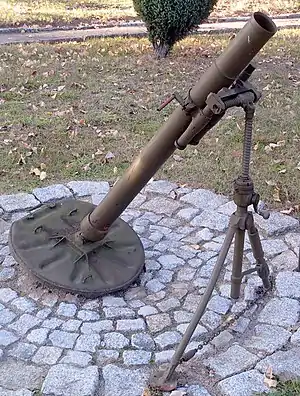 | Light infantry mortar. | |
| M1938 mortar | 120mm Heavy mortar |  | Heavy infantry mortar. | |
| 107mm M1938 mortar | 107mm Infantry mortar |  | It was a lighter version of the M1938 mortar made for Soviet mountain troops. |
Rocket launchers
| Name | Type | Origin | Photo | Notes |
|---|---|---|---|---|
| BM-13 "Katyusha" | 132mm Multiple rocket launcher |  | Most widely used multiple rocket launcher by the Red Army. It became known as "Stalin's organ" by German soldiers. | |
| BM-8 | 82mm Multiple rocket launcher | 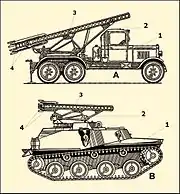 | Smaller rocket launchers that were mounted on T-40 and T-60 light tanks. | |
| BM-31 "Andryusha" | 300mm Multiple rocket launcher |  | Heavy rocket launcher with 12 rocket tubes which used the chassis of a ZIS-12 and the American Lend-Lease Studebaker US6 U3 truck. |
Vehicular guns
| Name | Type | Origin | Photo | Notes |
|---|---|---|---|---|
| 45mm 20-K tank gun | 45mm Anti-tank gun |  | Many tanks and other armoured vehicles later used it as their main armament. | |
| 57mm ZiS-4 tank gun | 57mm Anti-tank gun |  | The main armament of the T-34-57, saw very limited usage in combat. | |
| 76.2 mm L-10 tank gun | 76mm Anti-tank gun |  | The main armament of the T-28 tank. | |
| L-11 76.2 mm tank gun | 76mm Anti-tank gun |  | The main armament of the T-34 Model 1940 tank. | |
| F-32 tank gun | 76mm Anti-tank gun | .jpg.webp) | The main armament of the KV-1 Model 1940 tank. | |
| F-34 tank gun | 76mm Anti-tank gun |  | The main armament of T-34-76 and KV-1 tanks. | |
| D-10 tank gun | 100mm Anti-tank gun |  | The main armament of the SU-100 tank destroyer. |
Field artillery
| Name | Type | Origin | Production | Photo | Notes |
|---|---|---|---|---|---|
| 76-mm regimental gun model 1927 | Regimental gun | Dec. 1928 – Dec. 1943: 18,116[4] | 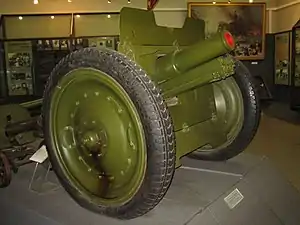 | The 76-mm regimental guns model 1927 together with the Soviet infantry passed the Battle of Lake Khasan and the Battles of Khalkhin Gol, the Winter War and the Great Patriotic War. During offensives, such regimental guns, which are respected by soldiers, had to follow by their crews directly in infantry combat formations in order to quickly suppress the enemy firepower, interfering with the advance of troops. Until 1941, the gun was produced at Kirov Plant in Leningrad, and in 1942–1943 at Plant No. 172 in Perm. | |
| 76 mm regimental gun M1943 | 76mm Infantry support gun |  | |||
| 76 mm mountain gun M1909 | 76mm Mountain gun |  | It became obsolete after it was replaced with several other mountain guns. | ||
| 76 mm mountain gun M1938 | 76mm Mountain gun |  | |||
| 76 mm divisional gun M1902/30 | 76mm Field gun |  | |||
| 76 mm divisional gun M1936 (F-22) | 76mm Field gun | 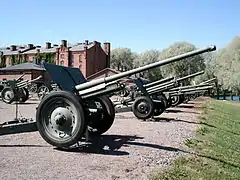 | Used during the Winter War. | ||
| 76 mm divisional gun M1939 (USV) | 76mm Field gun |  | |||
| 76 mm divisional gun M1942 (ZiS-3) | 76mm Field gun | _001.jpg.webp) | Field gun first deployed in 1941, very well-liked by Soviet and German soldiers because of its reliability, durability, and accuracy/ | ||
| 100 mm field gun M1944 (BS-3) | 100mm Field gun / Anti-tank gun |  | |||
| 107 mm divisional gun M1940 (M-60) | 107mm Field gun |  | |||
| 107 mm gun M1910/30 | 107mm Field gun | 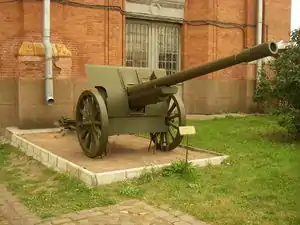 | |||
| 122 mm gun M1931 (A-19) | 122mm Field gun |  | |||
| 122 mm gun M1931/37 (A-19) | 122mm Field gun | _displayed_at_the_Museum_of_Heroic_Defense_and_Liberation_of_Sevastopol_on_Sapun_Mountain.JPG.webp) | |||
| 122 mm howitzer M1909/37 | 122mm Field howitzer | 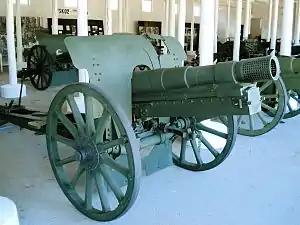 | |||
| 122 mm howitzer M1910/30 | 122mm Field howitzer |  | |||
| 122 mm howitzer M1938 (M-30) | 122mm Field howitzer | 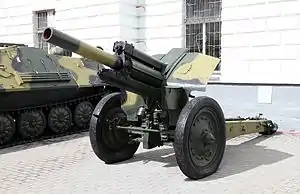 | |||
| 152 mm gun M1910/34 | 152mm Field gun |  | |||
| 152 mm gun M1935 (Br-2) | 152mm Heavy gun | 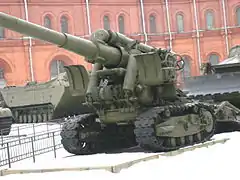 | It was used by the Red Army in the Battle of Kursk and Battle of the Seelow Heights. | ||
| 152 mm howitzer M1909/30 | 152mm Field howitzer |  | Most numerously used 152mm howitzer by the Red Army. | ||
| 152 mm howitzer M1910/37 | 152mm Field howitzer |  | |||
| 152 mm howitzer M1938 (M-10) | 152mm Field howitzer |  | |||
| 152 mm howitzer M1943 (D-1) | 152mm Field howitzer |  | |||
| 152 mm howitzer-gun M1937 (ML-20) | 152mm Field howitzer |  |
Fortress and siege guns
| Name | Type | Origin | Photo | Notes |
|---|---|---|---|---|
| 152 mm gun M1910/30 | 152mm Field howitzer | 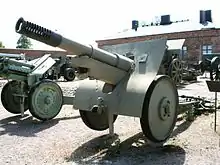 | ||
| 203 mm howitzer M1931 (B-4) | 203mm Heavy howitzer |  | It was used by the Red Army in the Battle of Berlin. | |
| 210 mm gun M1939 (Br-17) | 210mm Heavy howitzer |  | ||
| 280 mm mortar M1939 (Br-5) | 280mm Heavy mortar | 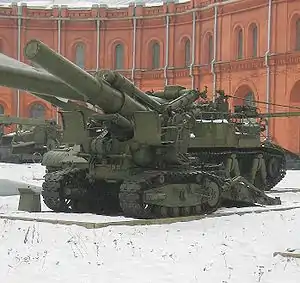 | ||
| 305 mm howitzer M1939 (Br-18) | 210mm Heavy howitzer |  |
Anti-tank guns
| Name | Type | Origin | Photo | Notes |
|---|---|---|---|---|
| 37 mm anti-tank gun M1930 (1-K) | 37mm Anti-tank gun | _gun.jpg.webp) | The gun was closely related to the German PaK 35/36. | |
| 45 mm anti-tank gun M1932 (19-K) | 45mm Anti-tank gun |  | ||
| 45 mm anti-tank gun M1937 (53-K) | 45mm Anti-tank gun |  | ||
| 45 mm anti-tank gun M1942 (M-42) | 45mm Anti-tank gun | _Museum_on_Sapun_Mountain_Sevastopol_1.jpg.webp) | ||
| 57 mm anti-tank gun M1943 (ZiS-2) | 57mm Anti-tank gun |  | ||
| 100 mm field gun M1944 (BS-3) | 100mm Anti-tank gun / Field gun |  |
Ground-based anti-aircraft weapons
Light anti-aircraft guns
| Name | Type | Calibre | Origin | Photo | Notes |
|---|---|---|---|---|---|
| DShK 1938 | Heavy machine gun | 12.7×108mm | 50-round belt. | ||
| 25 mm automatic air defense gun M1940 (72-K) | Air-defence gun | 25x218mmSR | 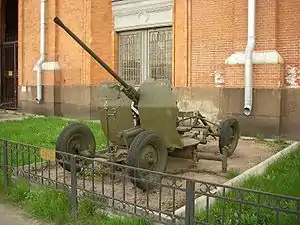 | ||
| 37 mm automatic air defense gun M1939 (61-K) | Air-defence gun | 37×250mmR |  | 200-rounds. | |
| 45 mm anti-aircraft gun (21-K) | Semi-automatic air-defence gun | 45×386mmSR |  | It was used by the Soviet Navy for most of their ships from 1934 as its primary light anti-aircraft gun until replaced by the fully automatic 37 mm 70-K gun from 1942 to 1943. | |
| 37 mm 70-K gun | Automatic air-defence gun | 37×250mmR | .jpg.webp) | Naval version of 37mm M1939 (61-K). |
Heavy anti-aircraft guns
| Name | Type | Calibre | Origin | Photo | Notes |
|---|---|---|---|---|---|
| 76 mm air defense gun M1938 | Semi-automatic air-defence gun | 76.2×558mmR |  | ||
| 85 mm air defense gun M1939 (52-K) | Semi-automatic air-defence gun | 85×558mmR |  | It was successfully used against level bombers and medium/high altitude targets. |
Armored fighting vehicles
Tankettes
| Name | Type | Origin | Quantity | Photo | Notes |
|---|---|---|---|---|---|
| T-27 | Tankette | 2,157 (1941) | 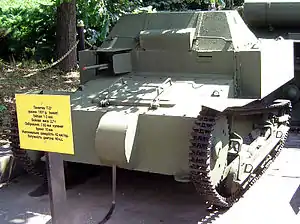 | The main armament was the 7.62mm DT light machine gun. Some were captured by Romanian forces. |
Tanks
| Name | Type | Origin | Production | Photo | Notes |
|---|---|---|---|---|---|
| T-18 (MS-1) | Light tank |  | Based on the French Renault FT tank. | ||
| T-26 | Light tank |  | Interwar period light tank that became the most numerous tank during the German invasion. | ||
| T-37A | Amphibious light tank | .jpg.webp) | |||
| T-38 | Amphibious light tank | 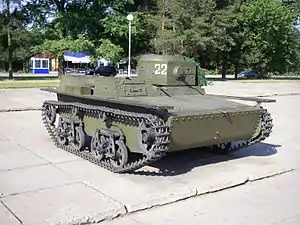 | |||
| T-40 | Amphibious scout tank |  | |||
| T-30 | Light tank | 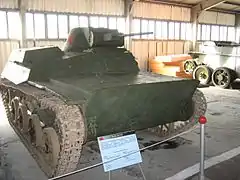 | |||
| T-50 | Light infantry tank | .jpg.webp) | |||
| T-60 | Light scout tank | .jpg.webp) | Replacement of the obsolete T-38 and T-30 tanks. | ||
| T-70 | Light tank | 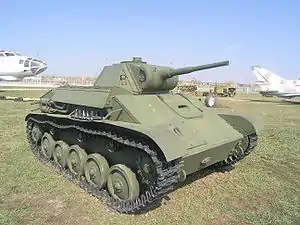 | |||
| BT-2 | Light cavalry tank |  | |||
| BT-5 | Light cavalry tank |  | |||
| BT-7 | Light cavalry tank |  | |||
| T-24 | Medium tank | 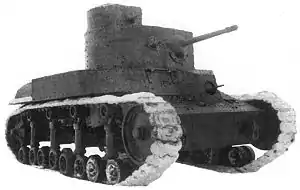 | |||
| T-28 | Medium tank | 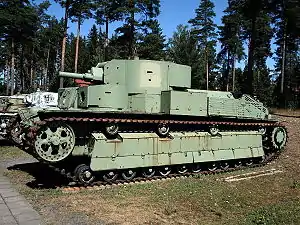 | |||
| T-34-76 | Medium tank |  | One of the most widely used tanks in the Red Army. 35,120 were produced. | ||
| T-34-85 | Medium tank | Jan. 1944 – Dec. 1946: 25,914 |  | A development of a deep modernization of T-34 tank (especially its armament) began in the autumn of 1943. To combat new German tanks, a powerful 85-mm ZIS-S-53 tank gun was mounted within a new turret for T-34. Tanks T-34-85 were produced by factories No. 112 (in Gorky), No. 183 (in Nizhny Tagil) and No. 174 (in Omsk). | |
| T-44 | Medium tank |  | |||
| T-35 | Heavy tank | 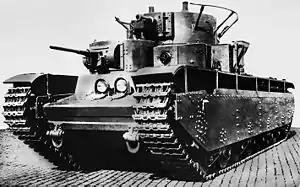 | During the war, they were slow and proved to be mechanically unreliable. 61 were produced. | ||
| SMK | Heavy tank prototype |  | Only one was produced, it was used during the Winter War. It was replaced by the KV tank series. | ||
| T-100 | Heavy tank prototype | 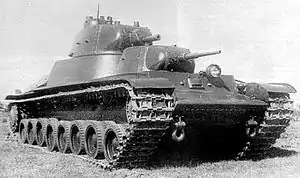 | Two were produced. There were unsuccessful trial uses of it during the Winter War. It was replaced by the KV tank series. | ||
| KV-1 | Heavy tank | 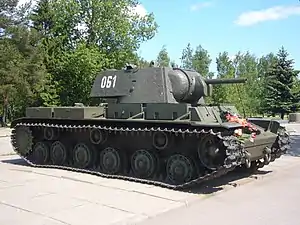 | Known for its strong armour, it became known as the "Russischer Koloss" – "Russian Colossus" by the German Army. | ||
| KV-2 | Heavy tank / Assault gun | 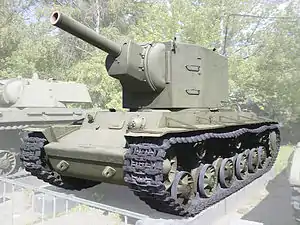 | The main armament was the 152mm howitzer. Due to its combat ineffectiveness, only 334 were produced . | ||
| KV-85 | Heavy tank |  | It became the basis for the IS Series tanks. | ||
| IS-1 | Heavy tank |  | The IS series was a successor to the KV tank series. IS-1 was a prototype version, which had 130 produced. | ||
| IS-2 | Heavy tank |  | 3,854 IS-2s were produced. | ||
| IS-3 | Heavy tank |  | 2,311 IS-3s were produced. |
Self-propelled guns
| Name | Type | Origin | Production | Photo | Notes |
|---|---|---|---|---|---|
| ZiS-30 | Light self-propelled gun | A self-propelled gun based on Komsomolets tractor fitted with 57 mm ZiS-2 Anti-tank gun. Only 100 were built. | |||
| SU-5-1 / SU-5-2 / SU-5-3 | Self-propelled gun | 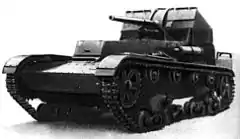 | A self-propelled gun that was on the T-26 light tank chassis. SU-5-1 was armed with the 76.2mm divisional gun mod. 1902/30. SU-5-2 was armed with the 122mm howitzer mod. 1910/30. | ||
| SU-5-3 | Self-propelled gun |  | It was on the T-26 chassis. Equipped with the 152mm mortar M1931. | ||
| SU-14 | Self-propelled gun prototype |  | One was built as a prototype. The main armament was the 152 mm gun (U-30 or BR-2). | ||
| SU-100Y | Self-propelled gun prototype |  | One prototype was made, based on the SU-100 tank and was used during the Winter War. The main armament was the 130mm Naval Gun B-13. | ||
| SU-26 | Self-propelled gun | 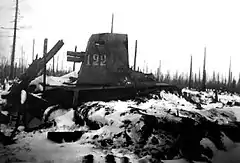 | Equipped with a 76 mm regimental gun M1927. | ||
| SU-76 / SU-76M | Light self-propelled gun | Dec. 1942 – Oct. 1945: 14,292 (560 SU-76 & 13,732 SU-76M)[5] |  | SU-76M was the 2nd most produced Soviet AFV of World War II, after the T-34 medium tank. Developed under the leadership of chief designer S.A. Ginzburg (1900–1943). This infantry support SPG was based on a lengthened T-70 light tank chassis and armed with ZIS-3 76-mm divisional field gun. | |
| SU-85 | Self-propelled gun | 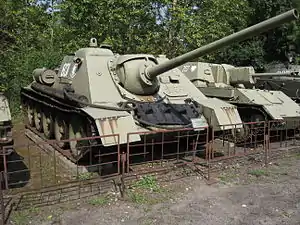 | A modification of SU-122 self-propelled gun based on T-34's chassis, equipped with 85 mm D-5S cannon. | ||
| SU-100 | Self-propelled gun |  | A modification of SU-85M that replaced it's 85mm gun with 100 mm D-10S. | ||
| SU-122 | Self-propelled gun |  | A self-propelled gun version based on T-34's chassis, equipped with 122 mm M-30S Howitzer. | ||
| SU-152 | Self-propelled gun | 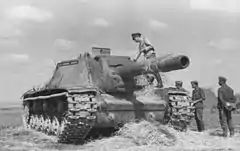 | Self-propelled gun based on KV-1S's chassis, equipped with 152 mm ML-20S howitzer. | ||
| ISU-122 | Self-propelled gun | 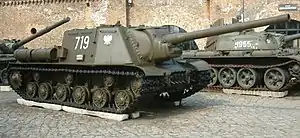 | A rearmed ISU-152 with 122 mm A-19S for ISU-122 and D-25S for ISU-122S. | ||
| ISU-152 | Self-propelled gun |  | Same role and armament as SU-152 but with IS-1's chassis |
Wheeled anti-tank self-propelled guns
| Name | Type | Origin | Photo | Notes |
|---|---|---|---|---|
| SU-4 | Wheeled self-propelled anti-tank gun |  | On the chassis of an extended GAZ-A. It was equipped with a 76 K/DRP recoilless gun. | |
| SU-12 | Wheeled self-propelled anti-tank gun |  | On the chassis of a GAZ-AAA. It was equipped with a 76 mm regimental gun M1927. |
Tracked anti-aircraft guns
| Name | Type | Calibre | Origin | Photo | Notes |
|---|---|---|---|---|---|
| SU-11 | Self-propelled air-defence gun | 37×250mmR | 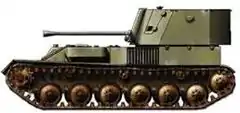 | It was equipped with the 37mm automatic air defence gun (61-К). | |
| ZSU-37 | Self-propelled air-defence gun | 37×250mmR |  | It was equipped with the 37mm automatic air defence gun (61-К). |
Armoured cars
| Name | Type | Origin | Photo | Notes |
|---|---|---|---|---|
| BA-27 | Armoured car | 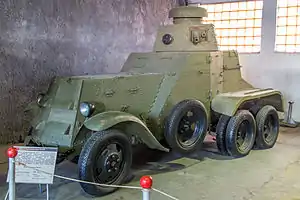 | First Soviet series-produced armoured car. The main armament was the 37mm Puteaux SA 18. Some were captured during the German invasion of the Soviet Union. | |
| D-8 | Armoured car |  | The main armament was two 7.62 DT light machine guns. It was used during the Winter War. | |
| FAI | Armoured car |  | Replacement for the D-8 armoured car. The main armament was the 7.62 DT light machine gun. | |
| BA-I | Armoured car | 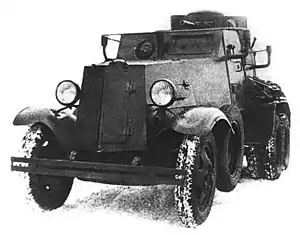 | Its main armament was the 37mm 7K gun. The design of the BA-I started a series of heavy armoured cars of Izhorsky plant. These included: BA-3, BA-6, BA-9, and BA-10. | |
| BA-3 | Armoured car |  | The main armament was the 45mm gun 20-K. | |
| BA-6 | Armoured car |  | Very similar to the BA-3. Both were used against the Japanese in the Battle of Khalkhyn Gol, in the Finnish Winter War, and against the Germans in the early stages of the Eastern Front. | |
| BA-10 | Armoured car |  | The main armament was the 45mm gun 20-K. | |
| BA-11 | Armoured car | 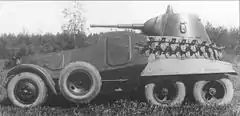 | The main armament was the 45mm gun 20-K. | |
| BA-20 | Armoured car | 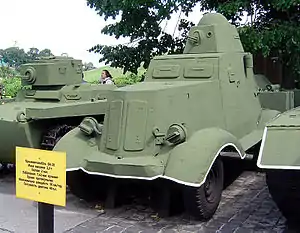 | Special armoured version of the GAZ-M1 passenger car. The main armament was the 7.62 DT light machine gun. | |
| BA-64 | Armoured scout car |  | Based and adapted from a captured German Sd.Kfz. 221. The main armament was the 7.62 DT light machine gun. |
Half-tracks
| Name | Type | Origin | Photo | Notes |
|---|---|---|---|---|
| BA-30 | Half-track |  | A small number of them were produced. The main armament was the 7.62 DT light machine gun. |
Lend-Lease tanks and SPGs
| Name | Type | Origin | Delivery | Photo | Notes |
|---|---|---|---|---|---|
| M3A1 (Stuart III) | Light tank | 1,233 |  | From 1941–1945, 1,676 were supplied by the United States as a part of the Lend-Lease.[6] 443 were lost at sea. | |
| M5 (Stuart VI) | Light tank | 5 |  | 5 were supplied.[6] | |
| M24 Chaffee | Light tank | 2 |  | 2 were supplied in 1944.[6] | |
| M4 Sherman | medium tank | 4,102 |  | 4,102 were suppiled, of these, 2,007 were the original 75 mm main gun model, 2,095 were with 76 mm tank gun.[7] | |
| Valentine tank | Infantry tank | 3,462 | 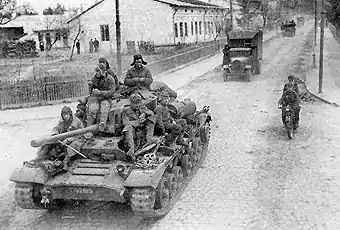 | 2,074 supplied by the UK, 1,388 supplied by Canada. 320 were lost at sea by both countries. | |
| T48 Gun Motor Carriage (SU-57) | Tank destroyer | 650 | .jpg.webp) | 650 were supplied.[6] On the chassis of the M3 Half-track equipped with a 57mm gun M1. It was designated as the SU-57 by the Soviet military. |
Motor vehicles
Trucks
| Name | Type | Origin | Photo | Notes |
|---|---|---|---|---|
| GAZ-AA | Truck |  | Soviet produced vehicle licensed from the Ford AA model of 1930. | |
| GAZ-AAA | Truck |  | ||
| GAZ-MM | Truck |  |
Passenger/utility vehicles
| Name | Type | Origin | Photo | Notes |
|---|---|---|---|---|
| GAZ-64 | Light utility vehicle |  | 2,500 were produced during the war. The focus switched to building armoured BA-64s, with the availability of American made Jeeps. | |
| GAZ-67 | Light utility vehicle |  | ||
| GAZ-M1 | Passenger car |  |
Lend-Lease vehicles
| Name | Type | Origin | Delivery | Photo | Notes |
|---|---|---|---|---|---|
| Dodge 3/4-ton WC series (Dodge 3/4) | Light military utility truck | 1942 – 1945: 25,124[8] | .jpg.webp) | Dodge WC series were one of the most popular vehicles during World War II. These U.S. military four-wheel drive vehicles (weapons carriers) were supplied to USSR under a Lend-Lease program mainly in two variants – with or without front winch (WC52 and WC51). With a payload of 750 kg (3/4 t), these 4 х 4 off-road vehicles with two seater open cab, multipurpose bed and canvas cover were intermediate between jeeps and trucks. |
Motorcycles
| Name | Type | Origin | Photo | Notes |
|---|---|---|---|---|
| PMZ-A-750 | Heavy motorcycle |  | The first heavy motorcycle manufactured in the Soviet Union. Used during the Winter War with unsatisfactory results. | |
| TIZ-AM-600 | Heavy motorcycle | Used during the Winter War with unsatisfactory results, it was considered an outdated design. | ||
| M-72 | Heavy motorcycle | 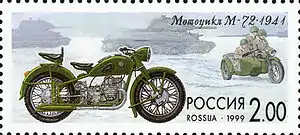 | Motorcycle meant to replace the PMZ-A-750 and TIZ-AM-600. In the Eastern Front, motorcycles were produced at both the IMZ and GMZ motorcycle plants. All sidecars for both the M-72 and American Lend-Lease bikes were produced at the GMZ. |
Tractors & prime movers
| Name | Type | Origin | Photo | Notes |
|---|---|---|---|---|
| S-60 | Tractor | .jpg.webp) | Heavy tractor with a strong engine meant to haul artillery. | |
| S-65 | Tractor | 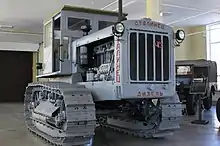 | Replacement of the S-60 for towing heavy weapons. Many of these and S-60s were captured by the German Army during their invasion. | |
| T-20 | Armoured tractor | 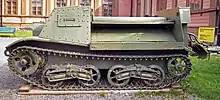 | These were most often used to haul artillery, carry troops, and unintentionally as a Tankette/Gun Carrier/APC. It was used during the Winter War and the first half of World War 2. They were often captured by the German Army and fitted with Pak guns. |
Aircraft
Fighter aircraft
| Name | Type | Origin | Production | Photo | Notes |
|---|---|---|---|---|---|
| Yak-9 | Fighter | Oct. 1942 – Dec. 1948: 16,769[9] | _(39004376092).jpg.webp) | Yak-9 was mass-produced in different variants (front-line fighter, fighter-bomber, high-altitude interceptor etc.) at three Soviet large aircraft plants - in Novosibirsk, Omsk and Moscow. Yak-9 was developed from the earlier Yak-1 and Yak-7 fighters of A.S. Yakovlev Design Bureau. Used in all major World War II operations of the Red Army, starting with the Battle of Stalingrad in autumn 1942. |
Navy ships
See also
- List of World War II weapons
- List of military vehicles of World War II
- List of British military equipment of World War II
- List of equipment of the United States Army during World War II
- List of German military equipment of World War II
- List of Italian Army equipment in World War II
- List of Japanese military equipment of World War II
References
- Cohen, Eliot A.; Glantz, David M.; House, Jonathan (1995). "When Titans Clashed: How the Red Army Stopped Hitler". Foreign Affairs. 75 (3): 306. doi:10.2307/20047605. ISSN 0015-7120. JSTOR 20047605.
- Monetchikov, Sergei (2005). История русского автомата [The History of Russian Assault Rifle] (in Russian). St. Petersburg: Military Historical Museum of Artillery, Engineers and Signal Corps. pp. 18–19. ISBN 5-98655-006-4.
- Sami Korhonen (1 November 2000). "Soviet artillery used the during Winter War". The Battles of the Winter War. Retrieved 22 April 2018.
- Shirokorad, Alexander (2000). Энциклопедия отечественной артиллерии [Encyclopedia of Russian Artillery] (in Russian). Minsk: Kharvest. p. 1156. ISBN 985-433-703-0.
- Chubachin, Alexander (2009). СУ-76. "Братская могила экипажа" или оружие Победы? [SU-76. “Mass Grave of the Crew” or Weapon of Victory?] (in Russian). Moscow: Yauza. BTV-Kniga. Eksmo. p. 112. ISBN 978-5-699-32965-6.
- "Lend-Lease Armoured Vehicles supplied to the Red Army 1941–1945". WW2 Weapons. 18 December 2017. Retrieved 13 May 2018.
- Lend-Lease Shipments: World War II, Section IIIB, Published by Office, Chief of Finance, War Department, 31 December 1946, p. 8.
- Kochnev, Evgenii (2010). Военные автомобили Союзников [Military Cars of the Allies] (in Russian). Moscow: Yauza. Eksmo. p. 512. ISBN 978-5-699-41199-3.
- Yakubovich, Nikolai (2008). Истребитель Як-9. Заслуженный «фронтовик» [Yak-9 Fighter. An Honored “Veteran”] (in Russian). Moscow: Kollektsia. Yauza. Eksmo. p. 112. ISBN 978-5-699-29168-7.